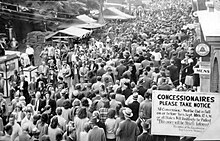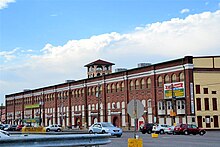Great Allentown Fair
| Great Allentown Fair | |
|---|---|
Agricultural | |
| Dates | Annually in late August and early September (August 28 to September 2 in 2024) |
| Location(s) | Allentown Fairgrounds, 302 N. 17th St., Allentown, Pennsylvania, U.S. |
| Years active | 1852–1861, 1863–1916, 1919–41, 1946–2019, 2021– |
| Website | http://www.allentownfairpa.org/ |
The Great Allentown Fair is an annual fair and agricultural show that is held at the Allentown Fairgrounds in Allentown, Pennsylvania. It is operated by the Lehigh County Agricultural Society.[1] It is one of the oldest fairs in the United States, and one of the largest in the state of Pennsylvania.
The fair was first held in 1852 to showcase agricultural advancements and to entertain patrons. It has since evolved to appeal to a broader audience, adding more entertainment and dining options.
History
Early history




The Lehigh County Agricultural Society held the first fair from October 6 to October 8, 1852, on Livingston's Lawn, a 5-acre (20,000 m2) plot located east of Fourth Street, between Walnut and Union Streets, in Allentown.[4][5] The initial fair was so successful that in 1853 the Society undertook the purchase of a larger plot of land, north of Liberty Street and between Fifth and Sixth Streets, on which ticket offices and a two-story exhibition hall were built.[6] This location was the site of the second fair, held September 28, 29 and 30 of the same year.[6] One of the most popular attractions of these early fairs was Stephen Lentz's Flying Coach, a brass band that performed atop a hay wagon.[5][7]
In 1862, there was no fair due to the Civil War. During this time, the fairgrounds were used as a staging site for the 176th Regiment of Pennsylvania Volunteers.[7] The fair resumed in 1863. In 1876, in celebration of the 100th anniversary of the signing of the Declaration of Independence, a large reenactment of the Battle of Bunker Hill was held, which included many of Lehigh County's Civil War regiments and veterans as participants.[8] The "centennial" fair was a tremendous success.[8]
New fairgrounds and name
Throughout the 1870s and 1880s, the popularity of the Allentown Fair continued to grow. However, increased attendance led to dissatisfaction regarding the fairground's size, facilities, short race track and small grandstand.[9] In 1889, the Lehigh County Agricultural Society purchased a plot of land on Seventeenth Street, between Chew and Liberty Streets, to serve as the new fairgrounds.[9] One of the primary features of the new location was a new half-mile race track, with grandstands capable of seating 2,500.[9] In celebration of the opening of the new fairgrounds, the fair was renamed the "Great Allentown Fair."[9]
20th Century
From its earliest days, horse racing was a popular event at the Allentown Fair. In 1902, the fair's half-mile track was regarded as "one of the finest in the country."[10] In 1905, racehorse Dan Patch set a record of 2:01 on the half-mile track.[11] In 1911, the present-day grandstand was built at the Allentown Fairgrounds, increasing the overall seating capacity from 2,500 to 10,000.
Between the years 1907 and 1914, airship races became a featured attraction at the fair.[12] In 1909, two airships - one bearing the American flag, the other that of Germany, took off from the fairgrounds, raced down Hamilton Street, circled the Soldiers & Sailors Monument, and returned. The airship bearing the American flag won the race.[12] The following year, pilot Glenn Curtiss took off in his plane, using 19th Street as his runway, and flew over the Allentown Fair, in what was the first known heavier-than-air flight in the Lehigh Valley.[11]
The first
There was no fair held in 1917 and 1918 due to World War I. During this period, the fairground was transformed into Camp Crane, a training facility for the United States Army Ambulance Service (USAAS). During this time, more than 20,000 soldiers lived in tents and barracks on the fairgrounds.[14] The caretaker's house, which stood at 1701 Chew Street until demolished in 1960 to make room for a bank, was used as the officer's club.[15]
The fair wasn't held between 1942 and 1945 due to World War II. In 1951, Gen. Douglas MacArthur, his wife, and his son Arthur attended "Father and Son" day at the Allentown Fair,[16] a visit described by local historian Frank Whelan as "probably among the most significant moments in the fair's history."[17]
Beginning in the 1950s, musical concerts and performances held during Fair week starting drawing major acts and large crowds.
21st century
In 2020, for the first time in 75 years, the festival was cancelled due to COVID-19 pandemic. It returned in 2021.
Attractions
The Great Allentown Fair offers many attractions, including:[3]
- Grandstand: A large outdoor stage featuring the fair's biggest musicians
- Farmerama Theater: An amphitheater where talent contests are held and assorted daytime entertainment takes place
- Music Tent: A tent where bands perform
- Main Entrance Plaza: An area where special shows, such as juggling acts, are held
- Powers Great American Midways: The fair's carnival
- Agriplex/Agriland: The fair's agricultural-themed areas
Grandstand performances
In 1911, a 7,070 seat grandstand was constructed at a cost of $100,000 to host horse racing and auto racing.[19]
In 1956, the grandstand was opened to major musician and band acts with Guy Lombardo the first booked grandstand act.[20]
See also
References
- Lehigh County Agricultural Society (1902), History of the Lehigh County Agricultural Society, Allentown, Pennsylvania: Berkemeyer, Keck & Co
Notes
- ^ a b "About The Great Allentown Fair". Archived from the original on July 4, 2008. Retrieved 2008-08-03.
- ^ "2008 Agri-Land Events". Archived from the original on July 4, 2008. Retrieved 2008-08-03.
- ^ a b "Entertainment At The Great Allentown Fair". Archived from the original on July 4, 2008. Retrieved 2008-08-03.
- ^ History of the Lehigh County Agricultural Society, p. 8
- ^ a b Nerl, Daryl (January 25, 2002), "Actors relive fair's genesis ** It was created in Allentown 150 years ago to entertain and promote farming.", The Morning Call, pp. B.01
- ^ a b History, p. 9
- ^ a b History, p. 13
- ^ a b History, p. 15
- ^ a b c d History, p. 17
- ^ History, page 25
- ^ ProQuest 393152499
- ^ ProQuest 393236340
- ^ ProQuest 393122405
- ^ Wlazalek, Ann (May 20, 2002), "Army's Camp Crane remembered at fairgrounds ** Allentown site saw World War I era of ambulance training.", The Morning Call, pp. B.1
- ^ Whelan, Frank (August 14, 2002), "Home used to house fair groundskeeper.", The Morning Call, pp. B.4
- ProQuest 393019311
- ProQuest 393090949
- ^ a b c d e f Wittman, Bob (August 25, 2002), "The Great Allentown Fair 150 Years 1852-2002 ** Why we're drawn to the fair.", The Morning Call, pp. S.01
- ^ "Allentown Fair - 1910-1941". www.allentownfairpa.org.
- ^ "Allentown Fair - 1942-1963". www.allentownfairpa.org.
